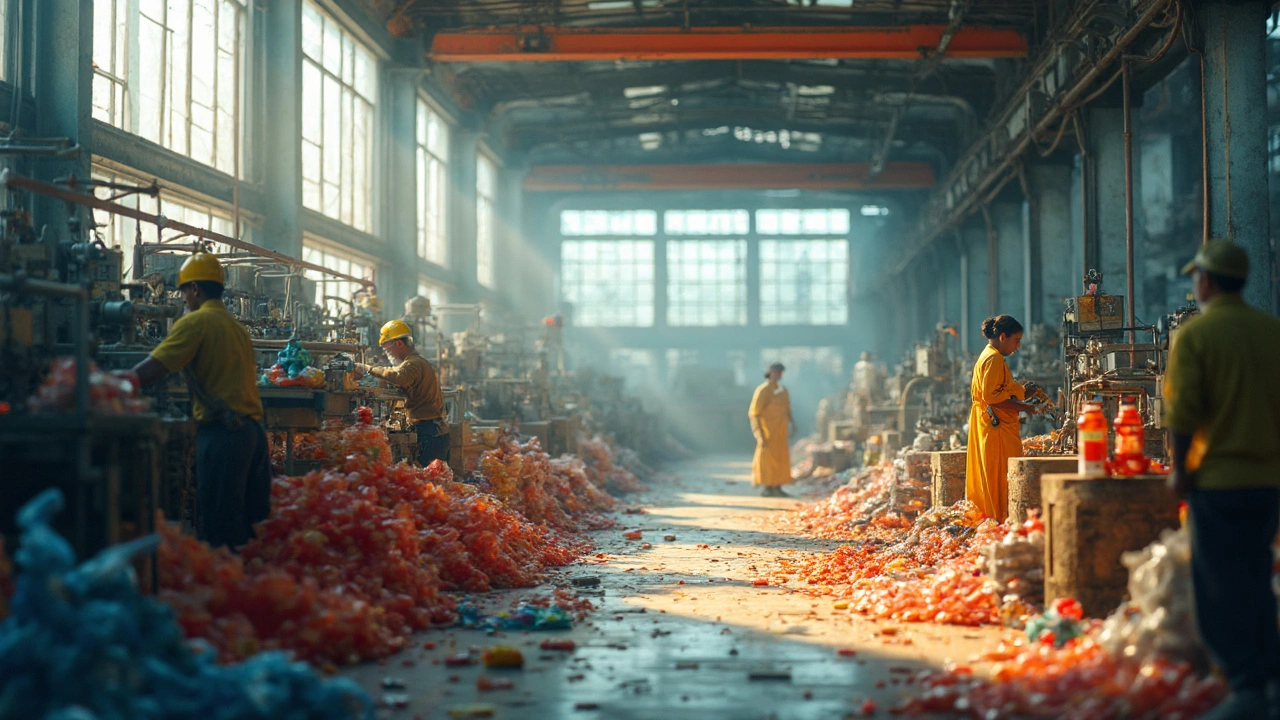Which Plastic Is in Demand: A Spotlight on Popular Plastics

Ever wondered why certain plastics pop up everywhere, while others don't get much attention? It's not just about what they're made of but how they're used and the advantages they bring to the table. Imagine trying to enjoy a chilled soda on a hot day without the PET bottles we often take for granted. PET, or polyethylene terephthalate if we're being formal, is one of the big names in the plastic world.
Why is PET in such high demand? For starters, it's lightweight, keeps your drinks fresh, and it's pretty easy to recycle, which gives it an eco-friendly badge. But PET is just one player in this vast field. Polyethylene (PE) and polypropylene (PP) are also plastics you can’t miss. They're the go-to materials for a ton of packaging solutions, from grocery bags to containers, because they combine toughness with flexibility like no other.
- The Need for Different Plastics
- Top Plastics in Manufacturing
- Versatile Plastics: PET & PE
- The Role of Sustainable Plastics
- Emerging Trends in Plastic Use
- Tips for Selecting the Right Plastic
The Need for Different Plastics
Plastics come in all kinds of types for a reason, and it's all about matching the right plastic to the right job. From carrying your groceries to making your phone case, different situations call for different types of plastics. Why? Because each plastic has its own strengths and weaknesses. Engineering the right characteristics is crucial to keeping things efficient, durable, and sometimes even safe.
Take a look at your kitchen. You probably have packaging around, and while they all do the same basic job—keeping your stuff fresh—the plastics used can vary widely. Polyethylene, for instance, is a pretty common choice for plastic wraps and storage because it’s flexible and durable. But when it comes to those frozen dinner trays, polypropylene is often preferred because it can stand the heat of a microwave without getting all melty or releasing harmful chemicals.
The Versatility of Plastics in Everyday Items
So, let's think about a few everyday items. Water bottles? Most likely made from PET. Grocery bags? High-density polyethylene (HDPE) or low-density polyethylene (LDPE) depending on how stretchy they are. Electronics cases? Definitely more solid stuff like acrylonitrile butadiene styrene (ABS). Different situations call for different types because what works great for a soda bottle won't cut it for your TV remote.
Perfecting the Plastic for the Task
Finding the right plastic is an industry in itself. Manufacturers consider factors like strength, flexibility, weight, and even color. And let’s not forget the growing focus on sustainability, pushing companies to look towards bio-based plastics or recycled plastics. It’s not just about what's cheaper; it’s about what’s fit for purpose and planet.
The plastic wave shows no signs of slowing, and as technology and industry needs change, so too will the types of plastics we depend on. Adaptability is key in this ever-demanding world.
| Plastic Type | Common Uses | Key Features |
|---|---|---|
| PET | Bottles | Lightweight, recyclable |
| HDPE | Grocery bags | Durable, flexible |
| ABS | Electronics cases | Tough, rigid |
Top Plastics in Manufacturing
When it comes to manufacturing, a few plastics stand out due to their versatility, reliability, and wide range of applications. These plastics are integral to various industries, making them highly sought after by plastic manufacturing companies worldwide.
Polyethylene (PE)
First on the lineup is Polyethylene, often abbreviated as PE. This is the most common plastic on earth, used for everything from plastic bags to bottles. It comes in two major forms: Low-Density Polyethylene (LDPE) and High-Density Polyethylene (HDPE). Each serves a different purpose.
- LDPE is used for bags, trays, and containers. It's flexible yet strong, perfect for packaging.
- HDPE finds its way into products like milk jugs, detergent bottles, and piping. It's tougher and stands up to chemicals better than LDPE.
Polypropylene (PP)
Next up is Polypropylene, or PP. Known for its ability to withstand high temperatures, PP is used in auto parts, textiles, and many food containers. Its versatility and durability make it a favorite for things that need a bit more resilience.
| Plastic | Main Use | Unique Property |
|---|---|---|
| PE | Packaging, bottles | Flexible, chemical-resistant |
| PP | Auto parts, textiles | Heat-resistant, durable |
Polyvinyl Chloride (PVC)
PVC has made quite a name for itself, especially in construction. Known for its strength and resistance to the elements, it's ideal for pipes, window frames, and flooring. Despite its rigidity, it can be made more flexible by adding plasticizers, which can be handy in applications like electrical cable insulation.
Polyethylene Terephthalate (PET)
Finally, there's the superstar, PET. Best known for its role in fabricating water and soda bottles, it's also popular in food packaging. It's transparent, lightweight, and most importantly, recyclable. If you've ever held a soda bottle, you've interacted with PET.
These plastics are not just materials; they're the backbone of countless products we use every day. From making our lives convenient to keeping our goods protected, they embody the innovation and adaptability of the modern plastic industry.
Versatile Plastics: PET & PE
When we talk about popular plastics, PET and PE are stars in the spotlight. Both have transformed the plastic manufacturing landscape thanks to their wide range of applications and handy properties.
Polyethylene Terephthalate (PET)
PET is a household name when it comes to beverage containers. It's the reason your soda stays fizzy and fresh. What makes PET stand out is its robustness combined with lightness—it’s durable yet easy to carry. Not to mention, it's pretty easy to recycle, which is a big win for the environmentally conscious crowd.
In the world of manufacturing, PET isn't just for bottles. It's used in fibers for clothing, containers for food, as well as some thermoforming applications, where it’s reshaped with heat into thin sheets. Plus, PET’s resistance to microorganisms makes it a hero in food packaging, keeping our snacks free from spoilage.
Polyethylene (PE)
Then there's Polyethylene, a jack-of-all-trades in the plastic universe. Coming in variants like HDPE (High-Density Polyethylene) and LDPE (Low-Density Polyethylene), this plastic type isn’t just versatile but also cost-effective. HDPE is famous for its sturdiness, making it ideal for products like detergent bottles and milk jugs. On the flip side, LDPE is celebrated for its flexibility, commonly used in plastic bags and film wrap.
The secret sauce of PE’s popularity lies in its adaptability. It can be molded into countless forms, making it vital for thousands of products we interact with daily. It's also resistant to a wide range of chemicals, meaning it's less likely to react with the everyday substances it might come in contact with.
Key Facts
- Both PET and PE are widely recyclable, helping reduce environmental footprints.
- PET’s demand skyrockets due to its use in the booming bottled beverage industry.
- PE maintains its position as a preferred choice for packaging due to its varied properties and low production cost.
These plastics have seen their demand soar, driven by the need for durable, yet lightweight and eco-friendly packaging solutions. From grocery stores to high-tech packaging plants, they make life easier and products better.

The Role of Sustainable Plastics
Sustainable plastics are riding the wave of environmental consciousness, and it's not just a temporary trend. These eco-friendly materials are changing how we think about and use plastics, transforming them from wasteful products into part of a circular economy. Pretty cool, right?
Why Choose Sustainable Plastics?
With more people worried about the environment, the demand for sustainable plastics in the plastic manufacturing industry is skyrocketing. These plastics are designed to reduce carbon footprints, using less energy to produce, and they often come from renewable resources. For instance, PLA (polylactic acid) made from corn starch, is a popular choice because it’s both compostable and biodegradable.
Consumers like knowing that these materials won’t just end up clogging rivers or spilling into the ocean. Instead, they break down more naturally, easing the burden on our planet's ecosystems.
Spotlight on Applications
Sustainable plastics aren't just a fancy concept; they're used in everyday products. From packaging to disposable cutlery, items we use daily are getting a green makeover. Even some electronics are incorporating these plastics as manufacturers look to sustainability as a selling point.
The automotive industry is also onboard; bio-based plastics are popping up in car interiors, reducing weight and increasing fuel efficiency. It’s proof that greener choices are as practical as they are trendsetting.
Buyer's Guide: What to Look For
- Check for certification labels that indicate a product's sustainability credentials.
- Do some research on whether the plastic is recyclable or compostable in your area.
- If possible, opt for products that use post-consumer recycled content.
Incorporating sustainable plastics into everyday products isn't just good for the earth; it's becoming a business standard. As the world shifts towards sustainable options, there's no better time to understand the role these plastics play in transforming traditional industries.
Emerging Trends in Plastic Use
Plastic use isn't just about making bottles and bags anymore. It's fascinating how industries are pushing the boundaries of what plastics can do. If you've been keeping an eye on the plastic industry, you'll know that sustainable plastics are a hot topic. Bioplastics, made from renewable sources like corn starch, are being explored as eco-friendly alternatives. They break down faster, reducing their imprint on the planet.
Biodegradable Innovations
Imagine a plastic that can vanquish sooner than your average one. That’s the promise of biodegradable plastics! These are engineered to break down more quickly under the right conditions. Especially in packaging, where lifespan can be short, these innovations are catching the eye of manufacturers looking to reduce waste.
Recycling and Reuse
Recycling has to be on the list! More companies are turning to recycled plastics to cut down on the production of new materials. You've probably seen shoes and clothes made from recycled bottles. It's not just a nod to sustainability; it’s becoming a smart, resource-saving habit that can even cut costs.
Technology and Smart Plastics
Then there are smart plastics, which are a game-changer. These are high-performance materials finding applications in electronics and healthcare. Think of plastics that change shape under heat or can conduct electricity. The smart plastics realm might sound a bit sci-fi, but it's becoming a reality in product design.
Industry Data on Growth
Check this out: a report found the global demand for bioplastics is growing by 20% annually. And, as sustainable practices become a priority for manufacturers, the numbers are expected to climb.
So, as plastic continues to evolve, keeping an eye on these emerging trends gives us a glimpse into the future of materials that are both versatile and environmentally conscious.
Tips for Selecting the Right Plastic
Choosing the right plastic for your project or product can feel a bit like picking the right tool from a massive toolbox. It's all about matching the plastic's properties with what you need it to do. Let's break down the key factors you should consider:
1. Consider the End Use
Think about what the product will be used for. If you're dealing with food packaging, PET is often the preferred choice because it’s safe for food contact and offers excellent barrier qualities. For making containers or bottles, PE and PP come in handy due to their lightweight and durable nature.
2. Environmental Impact
If sustainability is a priority for your brand, consider looking into bioplastics or recycled options. While they still compete with the big names like PET and PP, they're a step toward reducing environmental footprint. According to a recent study, “Plastics with lower environmental impacts are crucial for sustainable development.”
"The choice of plastic material significantly affects both the product's life cycle and the planet’s health," says Dr. Emily Watson, a renowned environmental scientist.
3. Cost vs. Benefit
Budget is always an issue, but remember, cheaper isn't always better. Evaluate not just the initial material cost, but also how it affects the production and the life span of the final product. Sometimes spending a bit more on plastics with better quality can lead to long-term savings.
4. Industry Standards and Regulations
Check for any standards or regulations related to your industry. For example, medical and food-related products have strict guidelines about the types of plastics that can be used. Ignoring these can lead to costly recalls or re-engineering, even major fines.
5. Mechanical and Thermal Properties
Depending on the application, mechanical properties like strength and flexibility, or thermal properties like resistance to temperature changes, will guide your choice. Make sure the material you select can stand up to the demands of its intended use.
6. Aesthetic and Branding Needs
Sometimes, the look and feel of the plastic itself play a huge part. If you want a glossy appearance or a certain color, you'll need to factor that in when selecting the material. PPE and PP are often used for products needing vibrant colors and finishes.
Keep these tips in mind the next time you're faced with deciding which plastic best suits your product needs. It's not one-size-fits-all, but more about finding that perfect fit!

